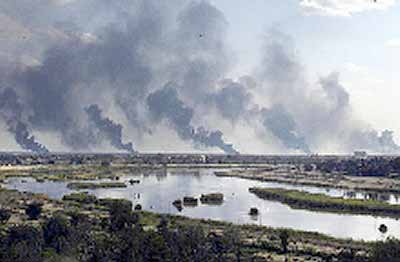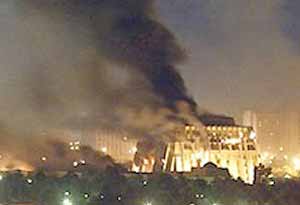| Blasts Rock Baghdad After
2-Day Assault
March 22, 2003 10:37 AM EST
Elsewhere, U.S. aircraft bombed Iraqi tanks holding bridges near Basra, the country's second-largest city. American officials said Saddam's regime was clearly losing control. In Baghdad, Information Minister Mohammed Saeed al-Sahhaf addressed the Iraqi people Saturday, assuring them that the government remained in power and had repulsed the U.S.-British attacks, destroying five tanks in the process. He also said those captives taken by coalition troops were civilians, not Iraqi soldiers. "Baghdad will remain with its head held high," Al-Sahhaf said. "The Baghdad of Saddam will remain defiant." Al-Sahhaf said 19 missiles had been fired upon a small area of Baghdad, injuring more than 200, mostly civilians. The blast at first light ended an eerie quiet that had fallen over Baghdad after a ferocious attack filled the sky with towering fireballs Friday night. Tomahawk missiles began to rain down just after 9 p.m. and air raid sirens squealed. Two Iraqi palaces and the intelligence headquarters were among the buildings destroyed. British Defense Secretary Geoff Hoon said the intelligence facility was struck by a Tomahawk fired from a British submarine. Allied ships in the Persian Gulf and Red Sea fired 320 Tomahawks in the strike - the third and largest since the war began. The attack apparently was coordinated to occur simultaneously with strikes on two other cities, Mosul and Kirkuk in the north and Basra and Nassiriyah in the south. The leader of one of the missions said a 30-plane strike force encountered no resistance from the air or ground during their six-hour mission. Commander Anthony Gaiani, aboard the USS Theodore Roosevelt, one of two carriers in the eastern Mediterranean, identified the complex as Ar Ramadi, on the Euphrates River, and said it consisted of two large palaces. "I really had thought that based on the type of target and the proximity to Baghdad they would put up more of a fight," he said. Three other carriers and their complement of cruisers and destroyers are launching similar strikes from the Persian Gulf region. The air barrage came with U.S. ground troops already a third of the way to Baghdad, and with Saddam and his regime fighting to demonstrate their control of the country despite reports of surrendering Iraqi troops and the loss of strategic sites. After the early morning blast Saturday, traffic returned to the streets of Baghdad, and workmen swept glass from the sidewalks around the badly damaged main presidential compound. A hole the size of two ping-pong tables had been blown in the dome of the Peace Palace, though four busts of Saddam still stood on the corners of the building. The intelligence headquarters was gutted and appeared to have taken a direct hit. Bricks, masonry and glass were strewn across the street in the al-Salhiya neighborhood. Friday night's spectacular blasts lit up the horizon, illuminating Baghdad even as they devastated parts of the city of 5 million people. Iraqi anti-aircraft bursts winked in the darkness. At one point, the sound of a missile roared through a street before exploding into a fireball. Hoon said the attacks on the Iraqi capital were carefully calibrated not to damage civilian targets or city infrastructure. "The lights stayed on in Baghdad, but the
instruments of tyranny are collapsing," Hoon said.
"They are a gang of war criminals ... international bastards," he said. "They lie day and night. They are not human." |

